Window sills aren’t just architectural features – they’re untapped goldmines for creating stunning indoor gardens. We’ve all walked past beautiful homes with lush greenery cascading from their windows and wondered how we could achieve that same magical effect in our own spaces.
The truth is window sill gardening offers the perfect solution for anyone craving more greenery without the commitment of elaborate indoor plant setups. Whether you’re dealing with limited space, tight budgets, or simply want to start small, your window sills provide the ideal microenvironment for plants to thrive.
We’re about to show you exactly how to transform those empty ledges into vibrant displays that’ll make your neighbors stop and stare. From selecting the right plants for different light conditions to maximizing every inch of space, you’ll discover why window sill gardening has become the go-to choice for both beginners and seasoned plant enthusiasts.
Choose the Right Window Sill Plants for Your Space
Plant selection can make or break your window sill garden’s success. We’ll guide you through the essential factors that determine which plants will thrive in your exact space.
Consider Light Requirements and Window Direction
South-facing windows provide 6-8 hours of direct sunlight daily, making them perfect for sun-loving plants like succulents, herbs, and flowering varieties. Cacti such as barrel cactus and prickly pear flourish in these bright conditions.
East-facing windows offer gentle morning sunlight for 4-6 hours, ideal for plants that prefer bright but indirect light. African violets, begonias, and most herbs grow exceptionally well in these locations.
West-facing windows deliver intense afternoon sun for 4-6 hours, which can be too harsh for delicate plants. Spider plants, pothos, and rubber trees adapt well to this challenging light pattern.
North-facing windows provide consistent low light throughout the day, perfect for shade-tolerant plants. Peace lilies, snake plants, and ZZ plants thrive in these conditions without requiring additional light sources.
Evaluate Available Space and Plant Size
Narrow window sills measuring 4-6 inches wide work best with small plants in 2-3 inch pots. Tiny succulents, air plants, and small herb seedlings maximize these compact spaces efficiently.
Standard window sills spanning 6-10 inches accommodate medium-sized plants in 4-6 inch containers. Pothos, small ferns, and compact flowering plants fit comfortably without overcrowding.
Deep window sills extending 10+ inches allow for larger plants and creative arrangements. Fiddle leaf fig saplings, monstera deliciosa, and substantial herb gardens can flourish in these generous spaces.
Vertical space above your sill determines plant height potential. Measure from the sill to any overhead obstruction to ensure your chosen plants won’t outgrow their allocated area.
Match Plants to Your Climate Zone
Tropical plants like philodendrons and ficus require consistent temperatures between 65-80°F and high humidity levels. These plants struggle in drafty windows or areas with important temperature fluctuations.
Temperate plants including most herbs and flowering varieties tolerate temperature ranges from 60-75°F. Basil, mint, and geraniums adapt well to moderate climate conditions found in most homes.
Desert plants such as succulents and cacti prefer warm, dry conditions with temperatures between 70-85°F. These plants excel in heated homes but may suffer in consistently cool environments.
Cold-hardy plants like certain ferns and evergreen varieties can withstand temperatures as low as 50°F. These resilient plants work well in unheated rooms or drafty window areas.
Prepare Your Window Sill for Optimal Plant Growth
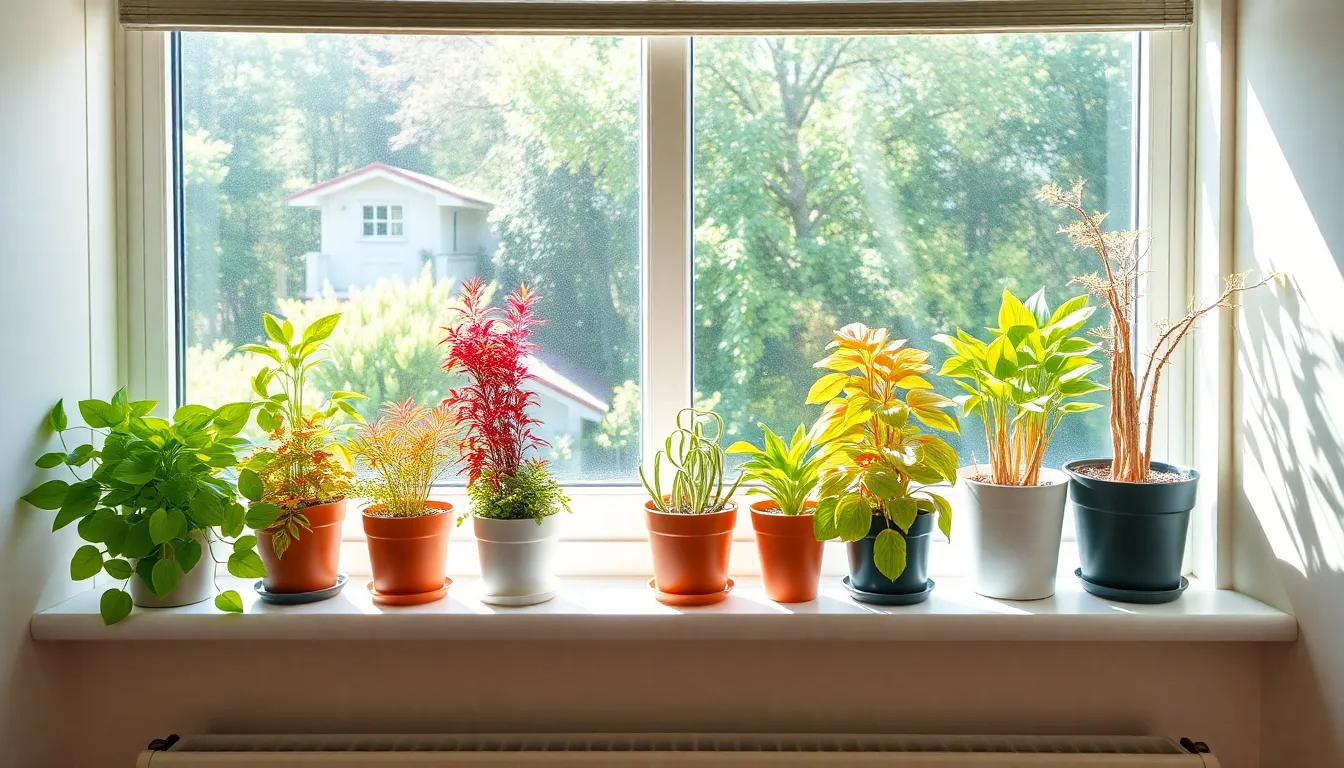
Now that we’ve selected the perfect plants for our space, we need to set up our window sill properly to ensure healthy growth and prevent damage to our home.
Clean and Assess Your Window Sill Surface
Thoroughly cleaning our window sill removes dust, dirt, and any old plant debris that could harbor pests or diseases that threaten plant health. We should inspect the surface carefully for sturdiness and evenness to make sure pots sit securely without tipping over. An unclean or unstable surface directly hinders plant growth and creates unnecessary risks for our indoor garden. Wiping down the area with a mild disinfectant eliminates potential pathogens while checking for any cracks or weak spots helps us address structural issues before placing heavy planters.
Install Proper Drainage Answers
Drainage systems prevent waterlogging, which causes root rot and kills our window sill plants quickly. We can drill drainage holes directly into pots or create false drainage by placing broken crockery or gravel at the bottom of planters to improve water flow. Ensuring excess water drains away maintains healthy root systems that support vigorous plant growth. Without proper drainage, even the most carefully selected plants will struggle and eventually fail regardless of ideal lighting conditions.
Add Protective Waterproof Barriers
Waterproof barriers like trays, saucers, or waterproof mats under our pots protect window sills from moisture damage that leads to decay or mold problems over time. These protective layers catch overflow water and prevent it from seeping into the sill material. Installing these barriers before placing plants saves us from costly repairs and maintains the structural integrity of our window area. We should choose barriers that complement our decor while providing complete coverage under each planter to maximize protection.
Select the Best Low-Light Plants on Window Sill Options
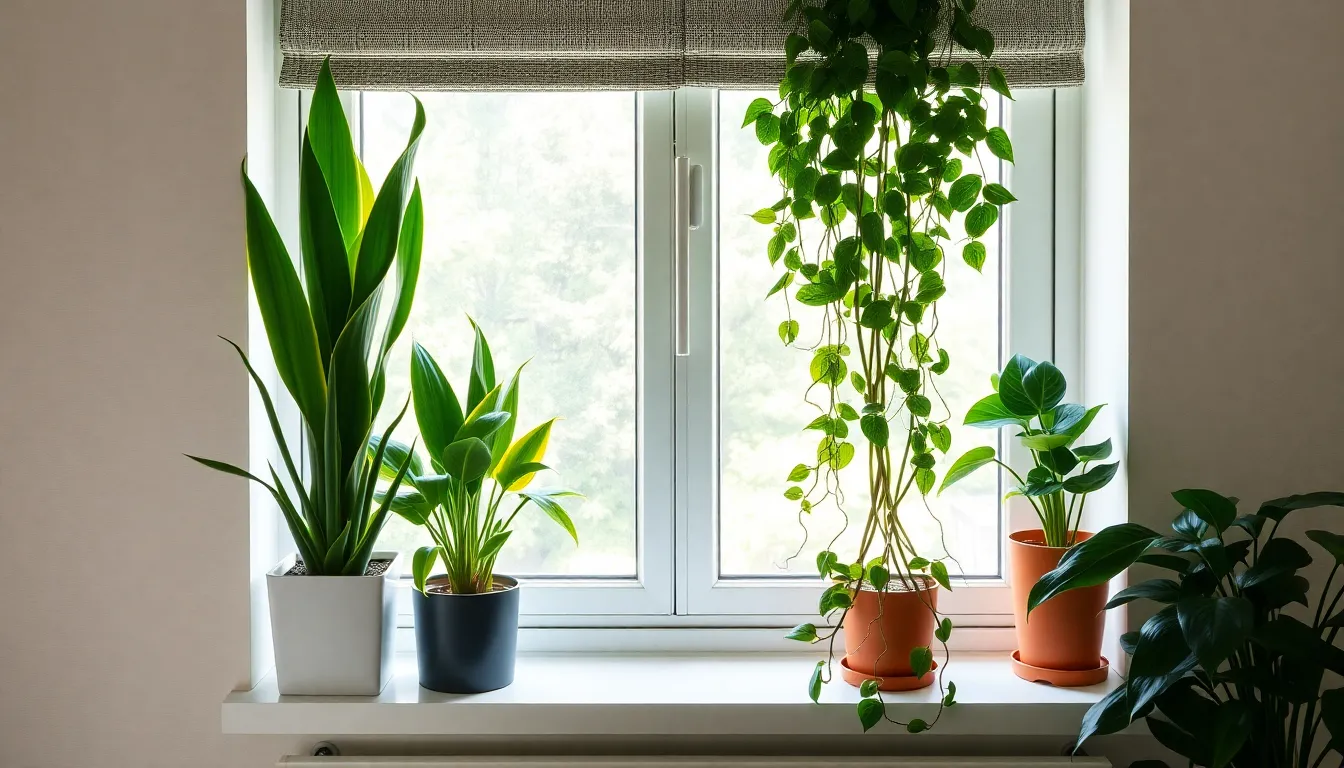
After evaluating your window sill conditions, choosing plants that thrive in minimal light becomes essential for creating a thriving indoor garden. These three exceptional varieties offer proven performance in low-light environments while requiring minimal care.
Snake Plants for Minimal Maintenance
Snake plants transform any window sill into an architectural focal point with their upright, sword-like leaves and striking appearance. These remarkable plants tolerate extremely low light conditions and survive with infrequent watering thanks to their succulent nature. We recommend snake plants for beginners because they’re virtually indestructible and adapt to almost any indoor environment.
Air Quality Benefits:
- Remove benzene and formaldehyde toxins
- Improve indoor air quality according to NASA’s Clean Air Study (1989)
- Continue purifying air even in shaded conditions
Care Requirements:
- Water only when soil completely dries out
- Thrive in indirect or minimal sunlight
- Survive neglect better than most houseplants
- Maintain their appearance without frequent attention
Pothos for Trailing Beauty
Pothos plants create stunning cascading displays with their heart-shaped leaves and trailing vines that naturally drape over window sill edges. Their variegated green foliage adds visual interest while adapting remarkably well to shaded spots throughout your home. We find pothos particularly appealing because they combine aesthetic beauty with exceptional durability.
Growth Characteristics:
- Develop trailing vines that hang gracefully
- Feature heart-shaped leaves in various green shades
- Adapt to low to moderate indirect light
- Continue growing even in challenging conditions
Maintenance Schedule:
- Water when soil feels dry to touch
- Forgive occasional watering mistakes
- Require minimal fertilization
- Enhance any space with their trailing habit
ZZ Plants for Forgiveness
ZZ plants deliver sculptural elegance with their glossy, dark green leaves and sturdy architectural form that complements modern interiors. These exceptionally forgiving plants store water in specialized rhizomes, making them perfect for busy lifestyles or frequent travelers. We consistently recommend ZZ plants because they thrive in the shadiest window sills where other plants struggle.
Drought Tolerance Features:
- Store water in underground rhizomes
- Survive extended periods without watering
- Maintain glossy appearance during neglect
- Recover quickly from underwatering
- Thrive in corners with minimal natural light
- Handle shade better than most houseplants
- Require no direct sunlight exposure
- Perfect for north-facing window sills with limited brightness
Maximize Sunlight with High-Light Window Sill Plants
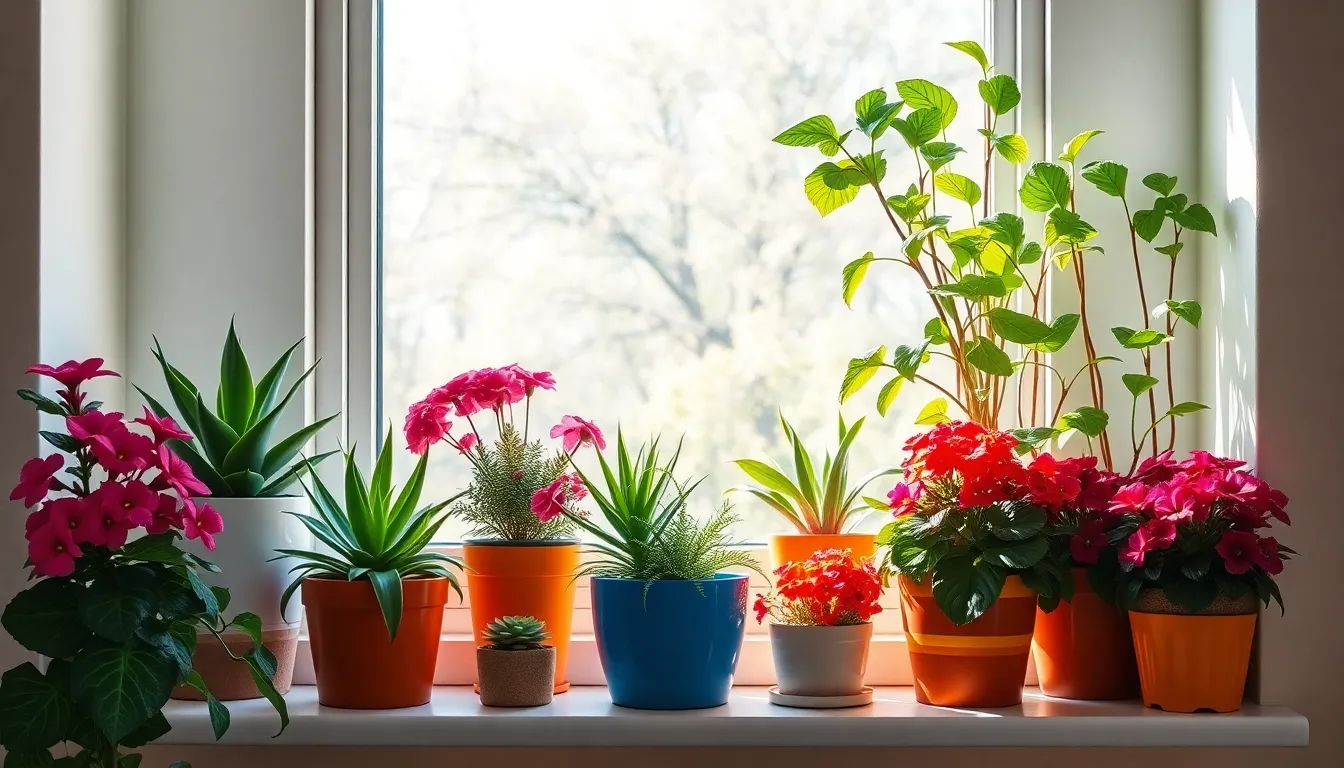
Bright, south-facing window sills offer the perfect opportunity to cultivate sun-loving plants that thrive in intense, direct light. We’ll explore the best options for these sunny spots where desert-adapted plants with fleshy, waxy, or silvery leaves excel.
Succulents for Bright Southern Exposures
Jade plants transform bright window sills into architectural showcases with their thick, glossy leaves that store water efficiently. These resilient plants require several hours of direct sunlight daily and tolerate dry soil conditions between waterings. Echeverias add rosette-shaped beauty to sunny exposures while demanding minimal maintenance beyond occasional watering when soil feels completely dry.
Aloe vera serves dual purposes as both a decorative element and a practical healing plant for your window garden. This succulent thrives in hot, dry conditions and stores water in its thick leaves, making it perfect for gardeners who prefer low-maintenance plants. We recommend rotating these plants weekly to ensure even growth and prevent leaning toward the light source.
Cacti varieties bring desert charm to bright window sills where they can receive the intense sunlight they crave. These plants have evolved to reflect sunlight through their waxy surfaces, preventing water loss while adding unique textures to your indoor garden display.
Herbs for Culinary Window Gardens
Basil flourishes on sunny window sills that provide at least six hours of direct sunlight daily, rewarding gardeners with fragrant leaves perfect for cooking. This herb requires moist but well-drained soil and benefits from regular harvesting, which encourages fresh, vigorous growth throughout the growing season.
Rosemary thrives in bright, warm conditions where it can develop its characteristic woody stems and needle-like leaves. We find this herb particularly valuable because it maintains its flavor intensity when grown in high-light window environments. Regular harvesting promotes bushier growth while providing fresh ingredients for Mediterranean dishes.
Thyme creates compact, aromatic additions to sunny window sill gardens where it can spread naturally in small containers. This hardy herb tolerates dry conditions between waterings and produces tiny flowers that add visual interest. Mint varieties also excel in bright window locations, though they require slightly more consistent moisture than other herbs.
Flowering Plants for Colorful Displays
Kalanchoes produce vibrant clusters of small flowers in bright window sill environments where they can photosynthesize efficiently. These succulent flowering plants combine the low-maintenance characteristics of desert plants with colorful blooms that last for weeks. We recommend choosing varieties in red, pink, yellow, or orange to create striking displays against green foliage.
Geranium varieties add bold splashes of color to high-light window gardens where they can bloom continuously throughout the growing season. These flowering plants prefer well-draining soil and benefit from deadheading spent blooms to encourage new flower production. Scented geraniums offer the additional benefit of releasing pleasant fragrances when their leaves are touched.
Air plants create unique flowering displays without requiring traditional potting soil, making them creative additions to bright window sills. These Tillandsia varieties absorb moisture and nutrients through their specialized leaves while producing colorful flower spikes in optimal light conditions.
Create Stunning Arrangements with Multiple Plants on Window Sill
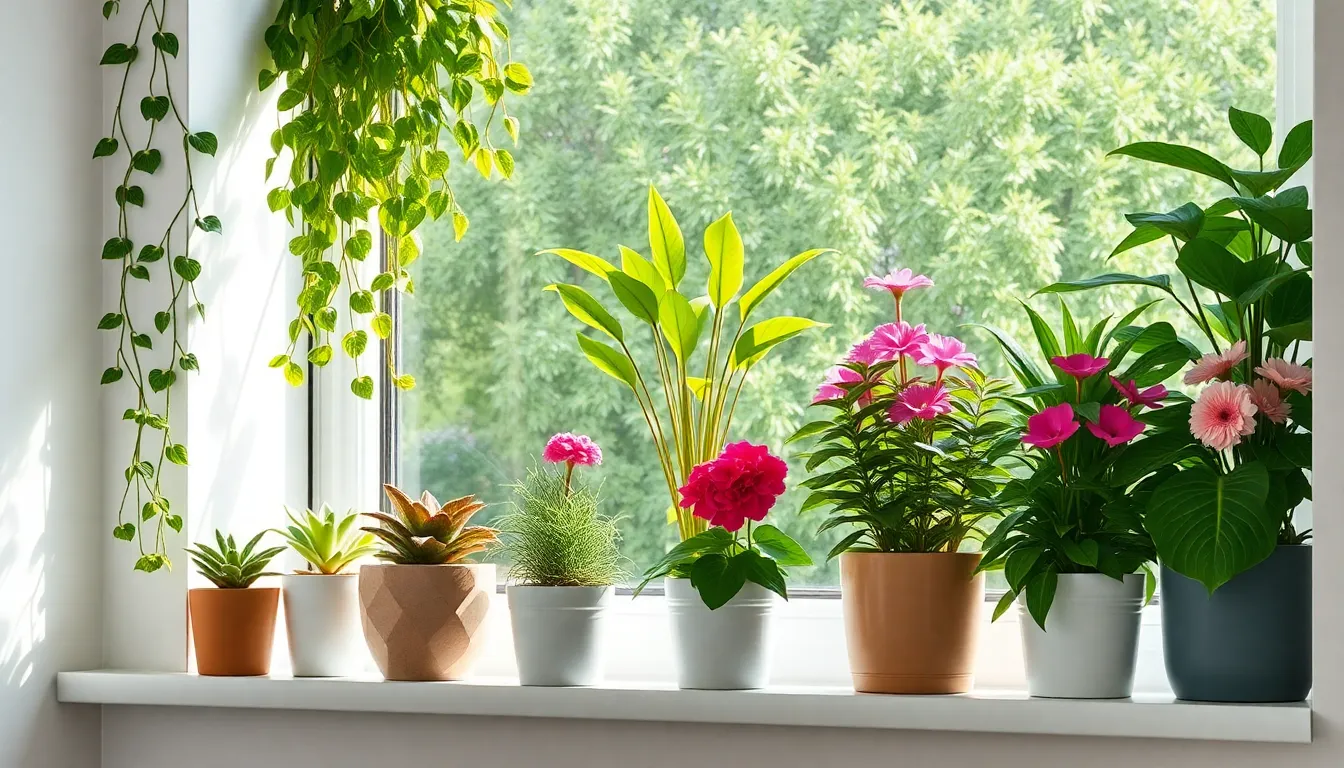
Now that we’ve chosen the perfect plants for our window sill conditions, let’s transform that space into a stunning display that captures attention and brings vibrant life to our indoor environment.
Layer Plants by Height and Texture
Arranging plants by varying their heights and textures creates visual interest that draws the eye naturally across our display. We place smaller plants directly on the sill while positioning taller plants behind them so each plant receives adequate light. Trailing plants such as Pothos or ivy add layers and depth to our arrangement, allowing some greenery to cascade over the edge for dramatic effect.
Odd numbered groupings of plants make our arrangement more ever-changing and captivating. Groups of three or five plants create better visual balance than even numbers. We use risers, stands, or stacked books to elevate some plants and add dimension to our display. This layering technique maximizes space while ensuring every plant gets proper light exposure.
Use Matching or Complementary Containers
Choosing containers that either match or complement each other unifies our display and creates a cohesive look. For colorful arrangements, we opt for simple, neutral colored pots that allow the plants’ natural hues to stand out. A rustic copper window box pairs beautifully with bold flowers and creates an appealing contrast.
Selecting understated containers for trailing plants prevents them from detracting attention from the foliage itself. We choose pots that spill gracefully over the sill without overwhelming the space. The containers should support our plants’ growth while maintaining the overall aesthetic balance of our arrangement.
Balance Colors and Foliage Patterns
Mixing plants with different leaf shapes, sizes, and shades of green creates depth and visual complexity in our display. We add pops of color through flowering plants by selecting complementary color schemes such as blue and orange or purple and yellow. This color theory approach ensures our arrangement looks professionally designed.
Ensuring the plants we choose have similar light and watering needs keeps our arrangement thriving uniformly. We group plants with compatible care requirements together to simplify maintenance. We avoid overcrowding the window sill so sunlight can reach all plants and the window remains functional for daily use.
Master the Watering Techniques for Window Sill Gardens
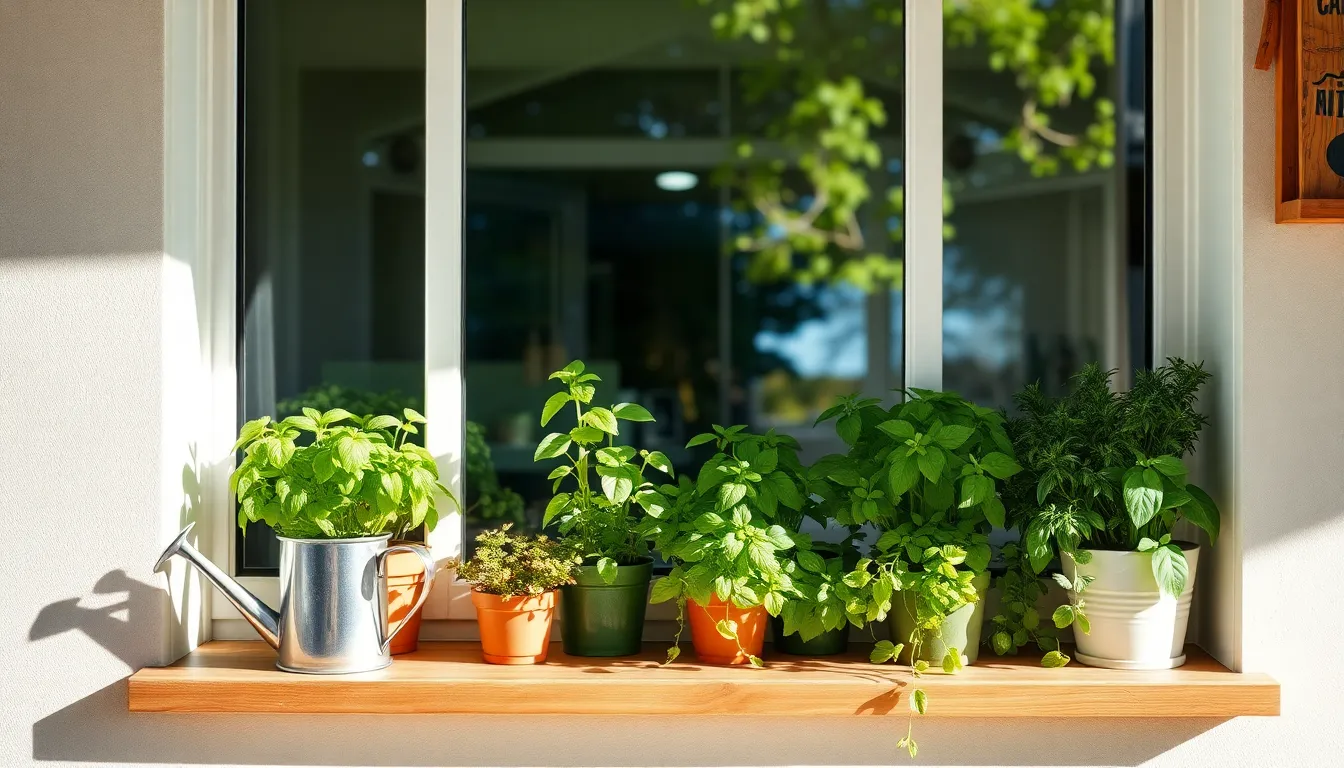
Water management stands as the cornerstone of successful window sill gardening. Understanding proper hydration techniques ensures your plants thrive rather than merely survive.
Establish Consistent Watering Schedules
Check the top layer of soil regularly by inserting your finger about an inch deep to determine when your plants need water. Dry soil at this depth signals it’s time to provide hydration, while moist soil indicates you can wait another day or two.
Different plants require varying moisture levels, so we adjust our watering frequency to match each plant’s exact needs. Herbs like basil prefer consistently moist soil, while succulents thrive with longer dry periods between waterings.
Keep soil moist but never soggy to prevent root damage and promote healthy growth. Monitor your plants’ response to your watering schedule and make adjustments based on seasonal changes and growth patterns.
Recognize Signs of Overwatering and Underwatering
Overwatering creates telltale signs including yellowing leaves, musty odors, and soft, blackened roots that indicate root rot. Excess moisture suffocates plant roots and creates an environment where harmful bacteria flourish.
Underwatering manifests through dry, wilting leaves, brittle stems, and soil that pulls away from container edges. Plants experiencing water stress often drop leaves or show stunted growth as they conserve energy.
Regular soil moisture checks help us avoid both extremes by providing early warning signs before permanent damage occurs. Touch the soil surface daily and observe your plants’ overall appearance to catch problems early.
Use Proper Drainage and Saucers
Containers with drainage holes prevent water from pooling at the bottom, which can suffocate roots and cause fatal root rot. We ensure every pot has adequate drainage before planting to maintain proper air circulation around the root system.
Saucers or trays placed under pots catch excess water while protecting window sill surfaces from moisture damage. Empty these collection trays within 30 minutes after watering to prevent plants from sitting in standing water.
Create a drainage layer using rocks or pumice beneath the soil in containers that lack drainage holes to improve water flow. This technique allows excess moisture to settle away from plant roots while maintaining proper hydration levels in the growing medium.
Address Common Problems with Plants on Window Sill
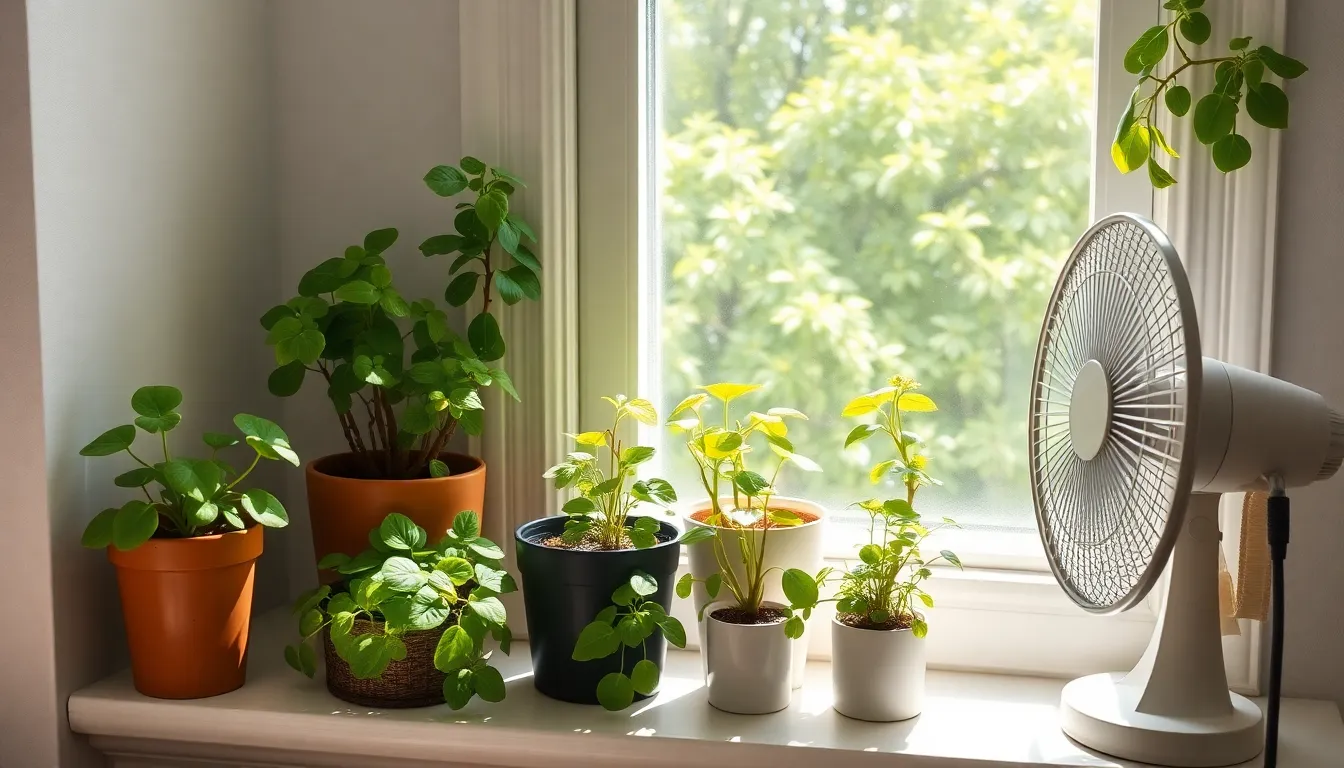
Even with proper selection and watering techniques, window sill gardening presents unique challenges that require exact answers. Understanding these common issues helps us maintain thriving indoor gardens year-round.
Prevent and Treat Pest Infestations
Regular inspection forms our first line of defense against common window sill pests like aphids, spider mites, and fungus gnats. We should examine our plants weekly for early warning signs such as tiny webs, sticky honeydew, or small flying insects around the soil surface.
Clean pots and fresh soil eliminate pest eggs before they can develop into full infestations. Starting with sterile containers and quality potting mix prevents many problems from occurring in the first place.
Safe antifungal agents and insecticides provide effective treatment when we catch infestations early. Applying these treatments before winter dormancy prevents pest buildup during the colder months when plants are more vulnerable.
Good air circulation around our plants reduces fungal infections that often accompany pest problems. Spacing plants appropriately and occasionally running a small fan nearby keeps air moving and creates an environment less favorable to pests.
Manage Temperature Fluctuations
Winter watering adjustments help our plants survive cold stress near glass surfaces that experience sharp temperature drops. We should reduce watering frequency and stop fertilizing completely to prepare plants for their natural dormancy period.
Transferring plants to cooler rooms protects them from extreme temperature swings that occur right against windows. Moving sensitive plants a few feet back from the glass often provides enough temperature stability.
Insulation techniques shield plant roots from cold drafts by placing foam padding or blankets underneath pots. This simple barrier prevents root damage that occurs when containers sit directly on cold window sills.
Monitoring for cold stress symptoms allows quick intervention when we notice leaf scorch, darkened foliage, or sudden wilting. Adjusting plant location and care routine based on these visual cues prevents permanent damage.
Deal with Limited Growing Space
Compact plant selection maximizes our window sill potential with varieties like Pilea peperomioides, Peperomia species, and air plants that naturally stay small. These plants thrive in confined spaces without becoming overcrowded.
Appropriately sized containers optimize available space without restricting root growth or creating instability. Choosing pots that fit comfortably while allowing proper drainage ensures both functionality and aesthetics.
Strategic grouping on trays catches water overflow while creating attractive arrangements that make efficient use of vertical space. Tiered plant stands and hanging elements extend our growing area beyond the flat surface.
Culinary herbs like basil and thyme serve dual purposes on sunny window sills by providing fresh ingredients while maintaining manageable size. These practical plants offer both beauty and functionality in limited spaces.
Style Your Window Sill Plant Display Like a Pro
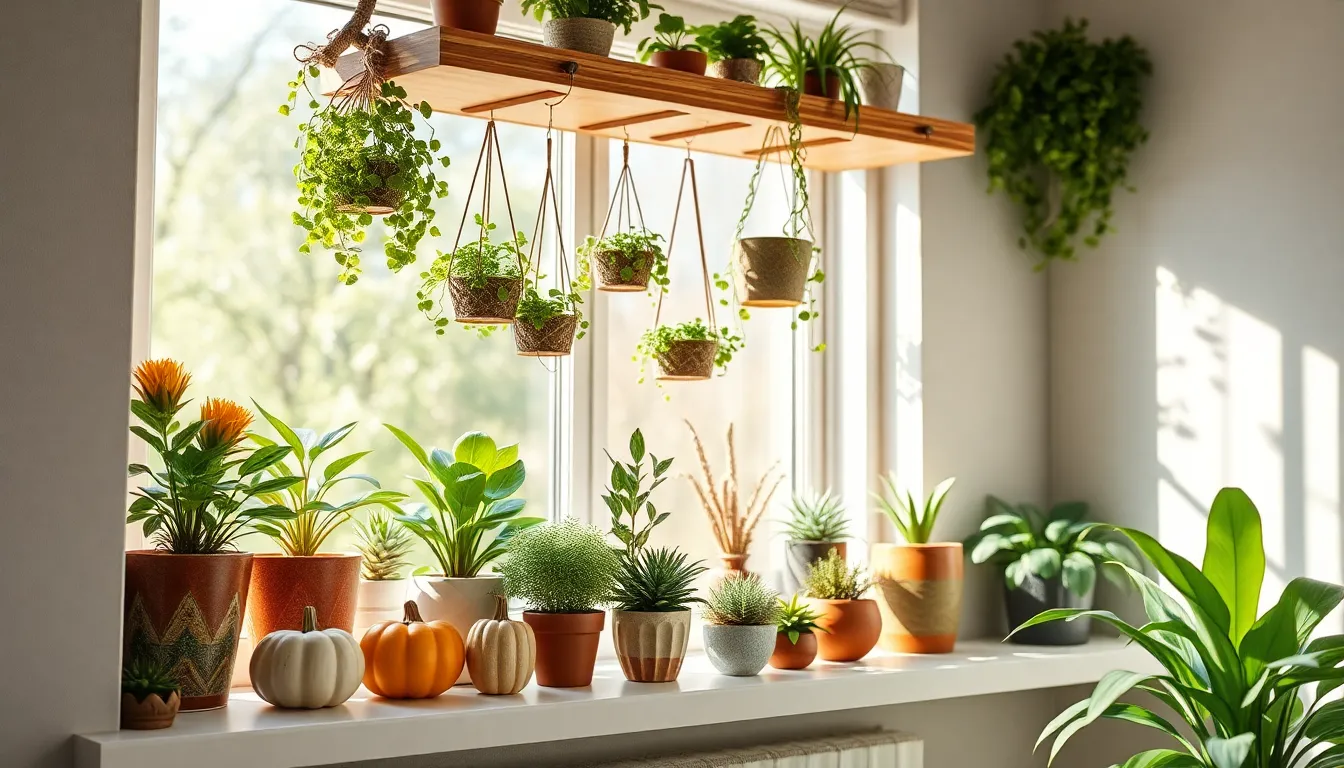
Transforming your window sill into a professional-looking display requires strategic styling techniques. We’ll show you how to elevate your plant arrangements with decorative touches, seasonal themes, and smart space answers.
Incorporate Decorative Elements and Accessories
Decorative pots and colorful planters instantly upgrade your window sill display’s visual appeal. We recommend choosing containers that complement your home’s color scheme while adding personality through unique textures and materials.
Small figurines create charming focal points between your plants without overwhelming the arrangement. Stones and pebbles serve dual purposes by improving drainage while adding natural texture to your display.
Matching accessories unify your plant collection and create a cohesive professional look. We suggest selecting decorative elements that reflect your personal style while maintaining the overall aesthetic balance.
Create Seasonal Themed Arrangements
Seasonal decor keeps your window sill display fresh and captivating throughout the year. We recommend incorporating small pumpkins and autumn-colored pots during fall months to celebrate the changing seasons.
Winter holidays offer opportunities to add festive touches like poinsettias or miniature ornaments. Spring arrangements benefit from bright, cheerful containers that reflect the season’s renewal energy.
Rotating seasonal elements prevents your display from becoming stagnant while maintaining visual interest. We suggest planning seasonal changes in advance to ensure smooth transitions between different themed arrangements.
Use Shelving to Maximize Vertical Space
Shelving dramatically increases your growing capacity when window sill space is limited or crowded. Clear glass shelves maintain the window’s natural light flow while creating additional planting surfaces.
DIY wooden shelves offer customizable answers that match your exact space requirements and style preferences. Hanging shelves positioned above or in front of windows create multidimensional displays without cluttering the original sill surface.
Layered plant arrangements at different heights optimize natural light usage while creating lush, professional-looking displays. We recommend placing light-sensitive plants on higher shelves to pull them away from direct sunlight while keeping them near beneficial window light.
Ceiling hooks and hanging plants complement window sill displays by extending the greenery vertically. This approach maximizes your indoor garden’s visual impact while maintaining the window’s functionality for daily use.
Maintain Year-Round Health for Your Window Sill Plants
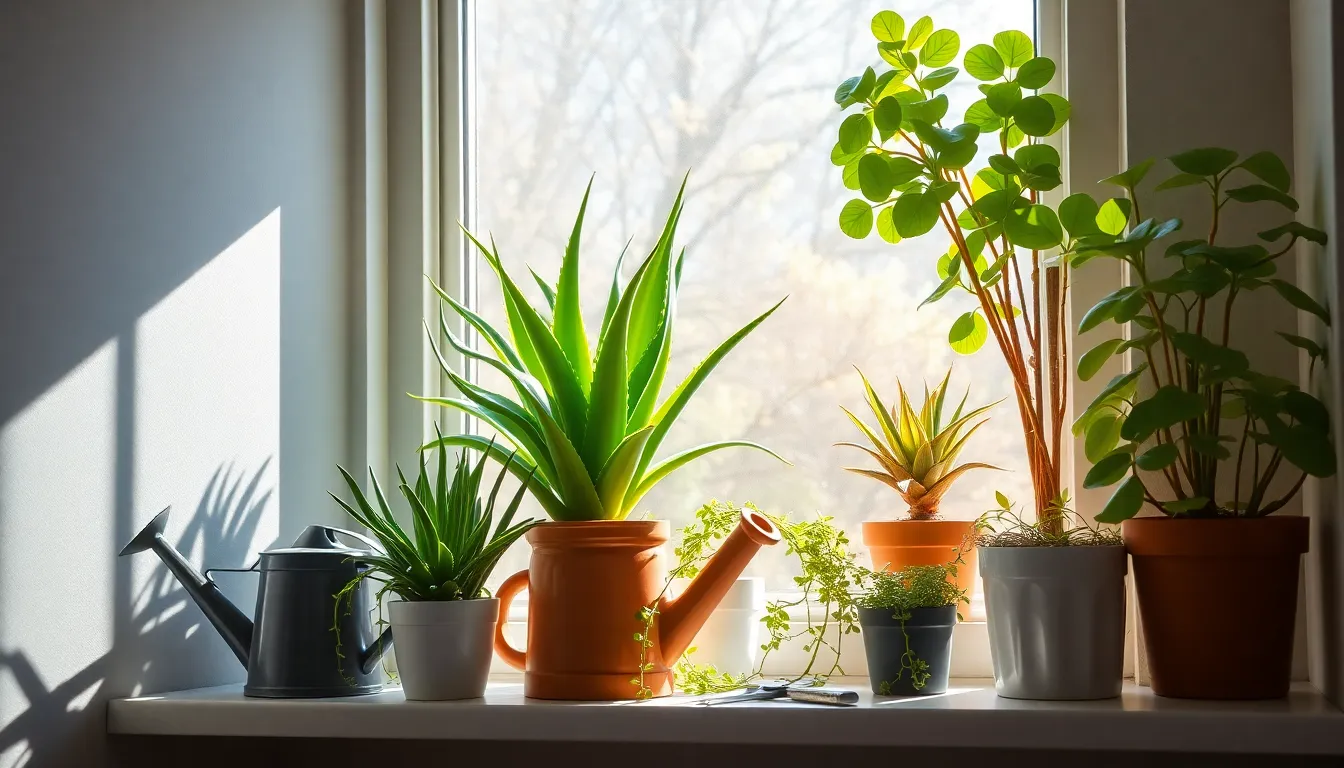
Keeping window sill plants thriving throughout the year requires strategic care adjustments and consistent maintenance practices. We’ll ensure our green companions stay vibrant by adapting to seasonal changes and implementing proven growth techniques.
Adjust Care Routines by Season
Spring and summer bring active growth periods when we should water regularly while allowing soil to dry between sessions, especially for succulents like aloe vera and jade plants. During these warmer months, our plants benefit from consistent moisture and can handle more frequent fertilizing to support their vigorous development.
Winter care demands a completely different approach as we reduce watering frequency and stop fertilizing to prepare plants for their natural dormancy period. Moving plants to cooler, insulated areas helps them adapt to seasonal changes while increasing humidity and providing additional lighting compensates for reduced natural sunlight.
Antifungal treatments and insect pest control before winter protects our plants during their vulnerable dormant state. We should inspect each plant thoroughly and address any issues before the challenging winter months begin.
Rotate Plants for Even Growth
Regular rotation ensures all sides of our plants receive equal sunlight exposure, preventing the common problem of leaning toward light sources. We should turn each plant a quarter turn weekly to maintain balanced shapes and promote healthy foliage development across all surfaces.
Uneven growth becomes particularly noticeable in plants positioned against windows where one side consistently faces the glass. Rotation prevents this lopsided appearance while encouraging fuller, more symmetrical plant forms that enhance our window sill displays.
Prune and Propagate for Continued Beauty
Dead and yellowing leaves require immediate removal to encourage new growth and maintain the visual appeal of our window sill garden. Regular pruning keeps plants looking fresh while redirecting energy toward healthy foliage and potential flowering.
Propagation through cuttings or division expands our collection while maintaining the vibrancy of existing plants. We can create new plants from healthy specimens, ensuring continuous beauty on our window sills while sharing extras with friends or replacing aging plants.
Consistent observation helps us catch problems early: wilted leaves indicate underwatering, yellow leaves suggest overwatering, and brown crispy leaves signal excessive sun exposure or dehydration.
Conclusion
Window sill gardening offers us an accessible pathway to bring nature indoors regardless of our living space constraints. We’ve explored how understanding light conditions and plant requirements sets the foundation for thriving displays that enhance our homes year-round.
The key lies in matching our plant selections to our exact window conditions while implementing proper care techniques. From drainage systems to seasonal adjustments we can create sustainable indoor gardens that require minimal investment yet deliver maximum impact.
Whether we’re starting with low-maintenance options or expanding into elaborate arrangements our window sills can become focal points of natural beauty. With consistent care and attention to detail we’ll enjoy the benefits of fresh air improved aesthetics and the satisfaction of successful indoor gardening.
Frequently Asked Questions
What are the best plants for south-facing window sills?
South-facing windows receive the most direct sunlight, making them perfect for sun-loving plants. Succulents like Jade plants, Echeverias, and Aloe vera thrive in these bright conditions. Herbs such as Basil, Rosemary, and Thyme also flourish in sunny spots while providing culinary benefits. Flowering plants like Kalanchoes and Geraniums add vibrant blooms to your display.
Which plants work best for low-light window sills?
For low-light conditions, Snake Plants are excellent choices due to their minimal maintenance needs and air-purifying qualities. Pothos offer beautiful trailing foliage and adapt well to shaded spots. ZZ Plants are particularly drought-tolerant and thrive in minimal natural light. All three varieties require infrequent watering and are perfect for beginners.
How do I prevent overwatering my window sill plants?
Check soil moisture regularly by inserting your finger about an inch deep into the soil. Only water when the top layer feels dry. Use containers with drainage holes to prevent water from pooling at the bottom. Create a drainage layer with pebbles in pots without holes, and always use saucers to catch excess water.
What’s the best way to arrange multiple plants on a window sill?
Layer plants by height and texture to create visual interest, using odd-numbered groupings for better balance. Employ risers or plant stands to add dimension to your display. Match or complement container styles to unify the arrangement, and group plants with similar care requirements together to ensure they all thrive.
How do I prepare my window sill for planting?
Start by thoroughly cleaning the window sill surface to remove dust and debris. Assess the structural stability to ensure it can support your planned arrangement. Install proper drainage systems and add waterproof barriers like trays or saucers to protect the sill from moisture damage and prevent water staining.
What should I do about pests on my window sill plants?
Inspect your plants regularly to catch pest problems early. Use clean pots and fresh soil when repotting to prevent infestations. If you spot pests, isolate affected plants immediately and treat with appropriate organic or chemical solutions. Maintaining good air circulation and avoiding overwatering also helps prevent pest-friendly conditions.
How do I manage temperature fluctuations for window sill plants?
Monitor temperature changes, especially during winter when glass surfaces can become very cold. Move sensitive plants away from windows during extreme weather. Adjust watering schedules based on temperature – plants need less water in cooler conditions. Consider using insulating materials or moving plants temporarily during harsh weather periods.
Can I grow herbs on my window sill year-round?
Yes, many herbs thrive on sunny window sills throughout the year. Basil, Rosemary, and Thyme are excellent choices that provide both aesthetic appeal and culinary benefits. During winter, reduce watering and fertilizing as growth slows. Rotate herbs regularly for even growth and harvest frequently to encourage continued production.







